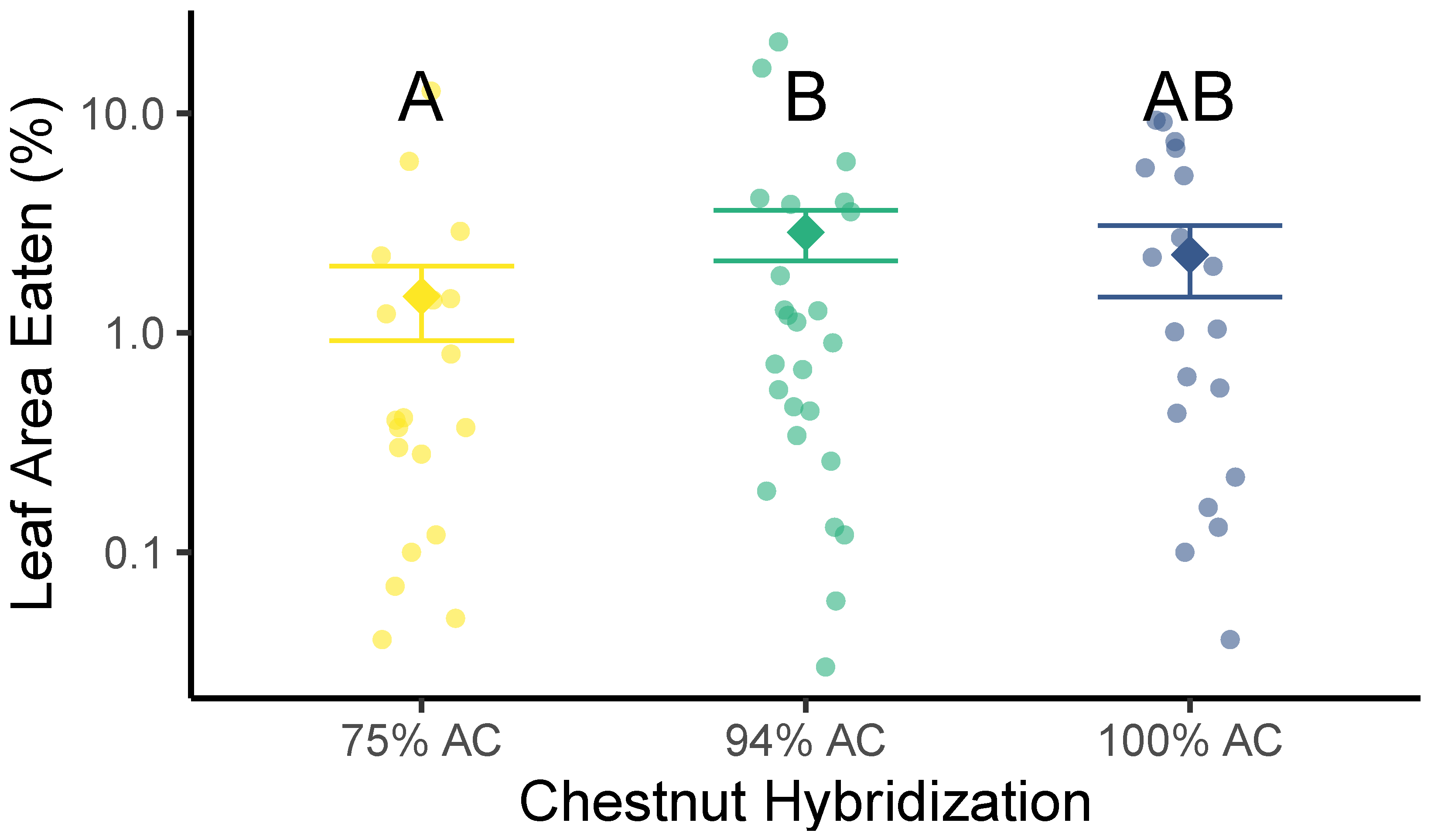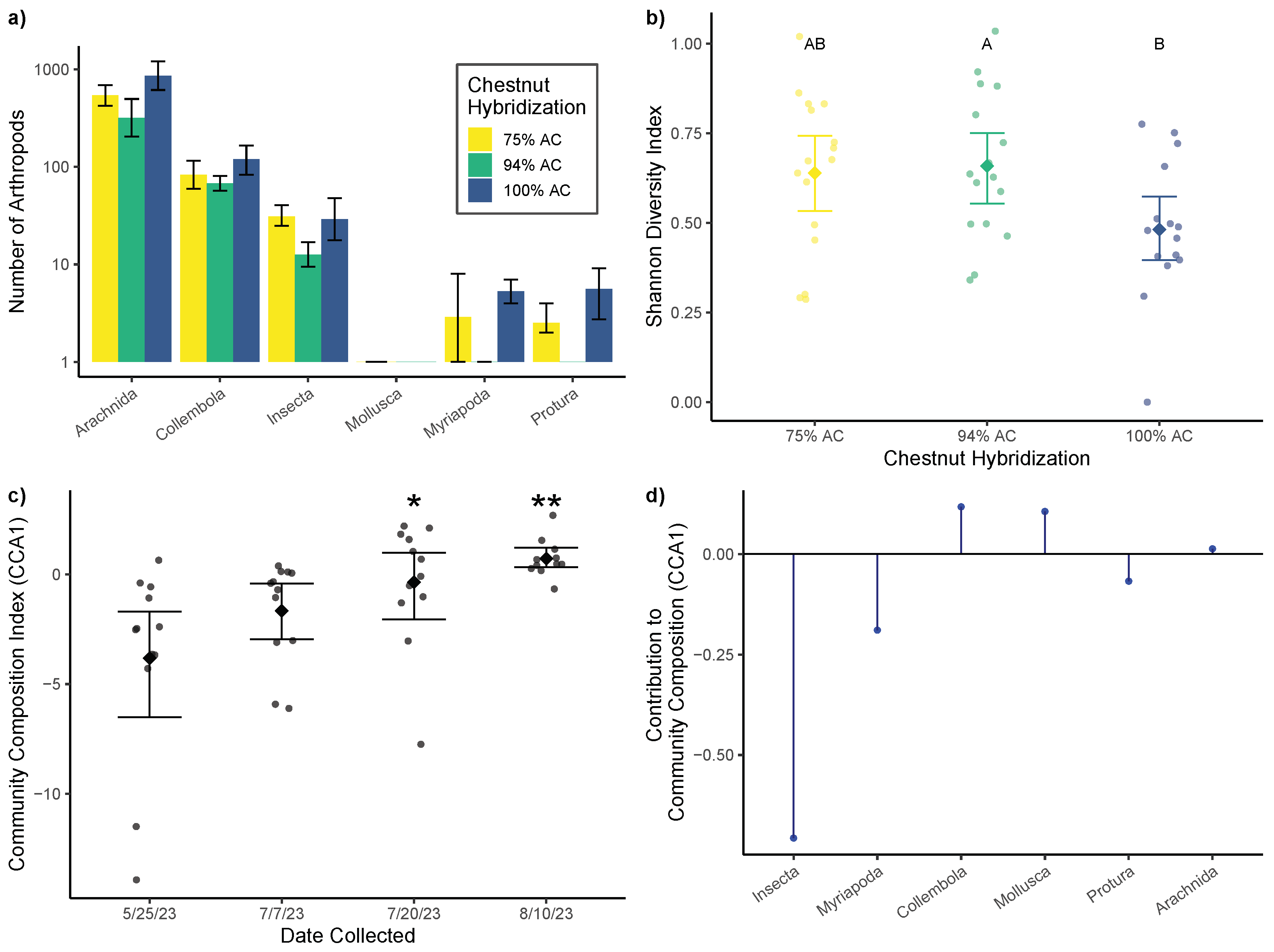Ecological Impact of American Chestnut Hybrid Restoration on Invertebrate Communities Above- and Belowground
Abstract
:1. Introduction
2. Materials and Methods
2.1. Experimental Design
2.2. Aboveground Insect Diversity
2.3. Insect Herbivory
2.4. Asian Chestnut Gall Wasp
2.5. Soil Arthropods
2.6. Entomopathogenic Nematodes
2.7. Statistical Analysis
3. Results
3.1. Aboveground Insect Diversity
3.2. Insect Herbivory
3.3. Asian Chestnut Gall Wasp
3.4. Soil Arthropods
3.5. Entomopathogenic Nematodes
4. Discussion
5. Conclusions
Author Contributions
Funding
Data Availability Statement
Acknowledgments
Conflicts of Interest
Abbreviations
| EPN | Entomopathogenic nematode |
| AC | American chestnut |
References
- Dalgleish, H.J.; Swihart, R.K. American chestnut past and future: Implications of restoration for resource pulses and consumer populations of eastern US forests. Restor. Ecol. 2012, 20, 490–497. [Google Scholar] [CrossRef]
- Kuhlman, E. The devastation of American chestnut by blight. In Proceedings of the American Chestnut Symposium, Morgantown, WV, USA, 4–5 January 1978; MacDonald, W.L., Ed.; West Virginia University Press: Morgantown, WV, USA, 1978. [Google Scholar]
- Jacobs, D.F. Toward development of silvical strategies for forest restoration of American chestnut (Castanea dentata) using blight-resistant hybrids. Biol. Conserv. 2007, 137, 497–506. [Google Scholar] [CrossRef]
- Clark, S.L.; Schlarbaum, S.E.; Saxton, A.M.; Baird, R. Eight-year blight (Cryphonectria parasitica) resistance of backcross-generation American chestnuts (Castanea dentata) planted in the southeastern United States. For. Ecol. Manag. 2019, 433, 153–161. [Google Scholar] [CrossRef]
- Filgueiras, C.C.; Willett, D.S. Phenology and monitoring of the lesser chestnut weevil (Curculio sayi). Insects 2022, 13, 713. [Google Scholar] [CrossRef]
- Labbate, L.; McCullough, D.G. Phenology, density and parasitism of Asian chestnut gall wasp (Dryocosmus kuriphilus) (Hymenoptera: Cynipidae) in recently invaded chestnut (Castanea spp.) orchards in Michigan. Environ. Entomol. 2022, 51, 747–762. [Google Scholar] [CrossRef] [PubMed]
- Avtzis, D.N.; Melika, G.; Matošević, D.; Coyle, D.R. The Asian chestnut gall wasp Dryocosmus kuriphilus: A global invader and a successful case of classical biological control. J. Pest Sci. 2019, 92, 107–115. [Google Scholar] [CrossRef]
- Fritz, R.S.; McDonough, S.E.; Rhoads, A.G. Effects of plant hybridization on herbivore-parasitoid interactions. Oecologia 1997, 110, 360–367. [Google Scholar] [CrossRef] [PubMed]
- Gehring, E.; Kast, C.; Kilchenmann, V.; Bieri, K.; Gehrig, R.; Pezzatti, G.B.; Conedera, M. Impact of the Asian chestnut gall wasp, Dryocosmus kuriphilus (Hymenoptera, Cynipidae), on the chestnut component of honey in the Southern Swiss Alps. J. Econ. Entomol. 2018, 111, 43–52. [Google Scholar] [CrossRef]
- Riga, F. Chestnut Gall Wasp (Dryocosmus kuriphilus Yasumatsu): Antennal Morphology and Natural Control. 2013. Available online: https://dspace.unitus.it/bitstream/2067/2730/1/friga_tesid.pdf (accessed on 19 May 2024).
- Bagyaraj, D.; Nethravathi, C.; Nitin, K. Soil biodiversity and arthropods: Role in soil fertility. In Economic and Ecological Significance of Arthropods in Diversified Ecosystems: Sustaining Regulatory Mechanisms; Springer: Singapore, 2016; pp. 17–51. [Google Scholar]
- Menta, C.; Remelli, S. Soil health and arthropods: From complex system to worthwhile investigation. Insects 2020, 11, 54. [Google Scholar] [CrossRef]
- Wagg, C.; Bender, S.F.; Widmer, F.; Van Der Heijden, M.G. Soil biodiversity and soil community composition determine ecosystem multifunctionality. Proc. Natl. Acad. Sci. USA 2014, 111, 5266–5270. [Google Scholar] [CrossRef]
- Kane, J.M.; Varner, J.M.; Saunders, M.R. Resurrecting the lost flames of American chestnut. Ecosystems 2019, 22, 995–1006. [Google Scholar] [CrossRef]
- Brown, V.; Lawton, J.H. Herbivory and the evolution of leaf size and shape. Philos.Trans. R. Soc. Lond. Ser. B Biol. Sci. 1991, 333, 265–272. [Google Scholar]
- Rieske, L.; Rhoades, C.; Miller, S. Foliar chemistry and gypsy moth, Lymantria dispar (L.), herbivory on pure American chestnut, Castanea dentata (Fam: Fagaceae), and a disease-resistant hybrid. Environ. Entomol. 2003, 32, 359–365. [Google Scholar] [CrossRef]
- Knops, J.M.; Tilman, D.; Haddad, N.M.; Naeem, S.; Mitchell, C.E.; Haarstad, J.; Ritchie, M.E.; Howe, K.M.; Reich, P.B.; Siemann, E.; et al. Effects of plant species richness on invasion dynamics, disease outbreaks, insect abundances and diversity. Ecol. Lett. 1999, 2, 286–293. [Google Scholar] [CrossRef] [PubMed]
- Price, P.W.; Bouton, C.E.; Gross, P.; McPheron, B.A.; Thompson, J.N.; Weis, A.E. Interactions among three trophic levels: Influence of plants on interactions between insect herbivores and natural enemies. Ann. Rev. Ecol. Syst. 1980, 11, 41–65. [Google Scholar] [CrossRef]
- McQueen, D.J.; Post, J.R.; Mills, E.L. Trophic relationships in freshwater pelagic ecosystems. Can. J. Fish. Aquat. Sci. 1986, 43, 1571–1581. [Google Scholar] [CrossRef]
- Fritz, R.S.; Simms, E.L. Plant Resistance to Herbivores and Pathogens: Ecology, Evolution, and Genetics; University of Chicago Press: Chicago, IL, USA, 2012. [Google Scholar]
- Whitham, T.G.; Morrow, P.A.; Potts, B.M. Plant hybrid zones as centers of biodiversity: The herbivore community of two endemic Tasmanian eucalypts. Oecologia 1994, 97, 481–490. [Google Scholar] [CrossRef] [PubMed]
- Choate, P. Introduction to the Identification of Adult Insects and Related Arthropods-2010. 2011. Available online: https://entnemdept.ufl.edu/choate/arthropod_id.pdf (accessed on 19 May 2024).
- Shannon, C.E. A Mathematical Theory of Communication. Bell Syst. Tech. J. 1948, 27, 379–423. [Google Scholar] [CrossRef]
- Simpson, E.H. Measurement of diversity. Nature 1949, 163, 688. [Google Scholar] [CrossRef]
- Machado, B.B.; Orue, J.P.; Arruda, M.S.; Santos, C.V.; Sarath, D.S.; Goncalves, W.N.; Silva, G.G.; Pistori, H.; Roel, A.R.; Rodrigues-Jr, J.F. BioLeaf: A professional mobile application to measure foliar damage caused by insect herbivory. Comput. Electron. Agric. 2016, 129, 44–55. [Google Scholar] [CrossRef]
- Foss, L.; Rieske, L. Stem galls affect oak foliage with potential consequences for herbivory. Ecol. Entomol. 2004, 29, 273–280. [Google Scholar] [CrossRef]
- Yahya, M.; Afzal, M.; Majeed, M.Z.; Sarwar, I.; Shehzad, K.; Luqman, M.; Sher, M.S. Differential impact of land-use, season and soil characteristics on the abundance of edaphic springtails (Insecta: Collembola) and mites (Arachnida: Acari). Pak. J. Zool. 2020, 52, 1483. [Google Scholar] [CrossRef]
- David Walter, H.C.P. Soil Microarthropods.
- Askary, T.H.; Jamal Ahmad, M.; Wani, A.; Mohiddin, S.; Sofi, M.A. Behavioural ecology of entomopathogenic nematodes, Steinernema and Heterorhabditis for insect biocontrol. In Sustainable Agriculture Reviews 31: Biocontrol; Springer: Cham, Switzerland, 2018; pp. 425–441. [Google Scholar]
- Biswal, D. Nematodes as ghosts of land use past: Elucidating the roles of soil nematode community studies as indicators of soil health and land management practices. Appl. Biochem. Biotechnol. 2022, 194, 2357–2417. [Google Scholar] [CrossRef]
- Filgueiras, C.C.; Shields, E.J.; Nault, B.A.; Willett, D.S. Entomopathogenic nematodes for field control of onion maggot (Delia antiqua) and compatibility with seed treatments. Insects 2023, 14, 623. [Google Scholar] [CrossRef]
- Orozco, R.A.; Lee, M.M.; Stock, S.P. Soil sampling and isolation of entomopathogenic nematodes (Steinernematidae, Heterorhabditidae). J. Vis. Exp. 2014, 89, e52083. [Google Scholar]
- Filgueiras, C.C.; Willett, D.S. Non-lethal effects of entomopathogenic nematode infection. Sci. Rep. 2021, 11, 17090. [Google Scholar] [CrossRef]
- R Core Team. R: A Language and Environment for Statistical Computing; R Foundation for Statistical Computing: Vienna, Austria, 2024. [Google Scholar]
- RStudio Team. RStudio: Integrated Development Environment for R; RStudio, PBC: Boston, MA, USA, 2020. [Google Scholar]
- Wickham, H.; Averick, M.; Bryan, J.; Chang, W.; McGowan, L.D.; François, R.; Grolemund, G.; Hayes, A.; Henry, L.; Hester, J.; et al. Welcome to the tidyverse. J. Open Source Softw. 2019, 4, 1686. [Google Scholar] [CrossRef]
- Müller, K. here: A Simpler Way to Find Your Files, 2020. R Package Version 1.0.1. Available online: https://cran.r-project.org/web/packages/here/here.pdf (accessed on 19 May 2024).
- Jackman, S. pscl: Classes and Methods for R Developed in the Political Science Computational Laboratory. University of Sydney, Sydney, Australia, 2024. R Package Version 1.5.9. Available online: https://github.com/atahk/pscl/ (accessed on 19 May 2024).
- Zeileis, A.; Kleiber, C.; Jackman, S. Regression Models for Count Data in R. J. Stat. Softw. 2008, 27, 1–25. [Google Scholar] [CrossRef]
- Lenth, R.V. emmeans: Estimated Marginal Means, aka Least-Squares Means, 2024. R Package Version 1.10.1. Available online: https://cran.r-project.org/web/packages/emmeans/emmeans.pdf (accessed on 19 May 2024).
- Wilke, C.O. cowplot: Streamlined Plot Theme and Plot Annotations for ’ggplot2’, 2024. R Package Version 1.1.3. Available online: https://cran.r-project.org/web/packages/cowplot/index.html (accessed on 19 May 2024).
- Oksanen, J.; Simpson, G.L.; Blanchet, F.G.; Kindt, R.; Legendre, P.; Minchin, P.R.; O’Hara, R.; Solymos, P.; Stevens, M.H.H.; Szoecs, E.; et al. vegan: Community Ecology Package, 2024. R Package Version 2.6-6. Available online: https://cran.r-project.org/web/packages/vegan/index.html (accessed on 19 May 2024).
- Fox, J.; Weisberg, S. An R Companion to Applied Regression, 3rd ed.; Sage: Thousand Oaks, CA, USA, 2019. [Google Scholar]
- Firke, S. janitor: Simple Tools for Examining and Cleaning Dirty Data, 2023. R Package Version 2.2.0. Available online: https://cran.r-project.org/web/packages/janitor/index.html (accessed on 19 May 2024).
- Sanguankeo, P.; León, R. Weed management practices determine plant and arthropod diversity and seed predation in vineyards. Weed Res. 2011, 51, 404–412. [Google Scholar] [CrossRef]
- Chowdhury, A.; Samrat, A.; Pandian, R.; Devy, S. Native tree species richness enhances matrix functionality for soil arthropods in tropical plantation landscapes: A case study from the Himalayas. Insect Conserv. Divers. 2022, 15, 621–633. [Google Scholar] [CrossRef]
- Tao, Y.; Wang, Z.; Ma, C.; He, H.; Xu, J.; Jin, Y.; Wang, H.; Zheng, X. Vegetation heterogeneity effects on soil macro-arthropods in an alpine tundra of the Changbai mountains, China. Plants 2019, 8, 418. [Google Scholar] [CrossRef] [PubMed]
- Muscolo, A.; Settineri, G.; Romeo, F.; Mallamaci, C. Soil biodiversity as affected by different thinning intensities in a Pinus laricio stand of Calabrian Apennine, South Italy. Forests 2021, 12, 108. [Google Scholar] [CrossRef]
- Huang, W.; González, G.; Barberena-Arias, M.F.; Zou, X. Litter decomposition and arthropod composition under different ultraviolet levels following prescribed burn in a subtropical pastureland. Biol. Fertil. Soils 2021, 57, 153–161. [Google Scholar] [CrossRef]
- Prather, R.M.; Castillioni, K.; Welti, E.A.; Kaspari, M.; Souza, L. Abiotic factors and plant biomass, not plant diversity, strongly shape grassland arthropods under drought conditions. Ecology 2020, 101, e03033. [Google Scholar] [CrossRef]
- Sosa, B.; Brazeiro, A. Local and landscape-scale effects of an ant nest construction in an open dry forest of Uruguay. Ecol. Entomol. 2012, 37, 252–255. [Google Scholar] [CrossRef]
- Wang, C.; Wang, G.; Wu, P.; Rafique, R.; Zi, H.; Li, X.; Luo, Y. Effects of ant mounds on the plant and soil microbial community in an alpine meadow of Qinghai–Tibet plateau. Land Degrad. Dev. 2017, 28, 1538–1548. [Google Scholar] [CrossRef]
- Torello Marinoni, D.; Nishio, S.; Valentini, N.; Shirasawa, K.; Acquadro, A.; Portis, E.; Alma, A.; Akkak, A.; Pavese, V.; Cavalet-Giorsa, E.; et al. Development of High-Density Genetic Linkage Maps and Identification of Loci for Chestnut Gall Wasp Resistance in Castanea spp. Plants 2020, 9, 1048. [Google Scholar] [CrossRef]




| Chestnut Hybrid | American | Chinese | Location | Year Planted | Mean Height | Mean Diameter | Number of Trees (N) |
|---|---|---|---|---|---|---|---|
| 100% AC | 100% | 0% | 35.21939, −82.59705 | 2013 | 35.89 cm | 6.98 mm | 46 |
| 94% AC | 94% | 6% | 35.21192, −82.59662 | 2014 | 3.9 m | 3.05 cm | 62 |
| 75% AC | 75% | 25% | 35.21606, −81.59480 | 2009 | 4.27 m | 5.2 cm | 30 |
Disclaimer/Publisher’s Note: The statements, opinions and data contained in all publications are solely those of the individual author(s) and contributor(s) and not of MDPI and/or the editor(s). MDPI and/or the editor(s) disclaim responsibility for any injury to people or property resulting from any ideas, methods, instructions or products referred to in the content. |
© 2024 by the authors. Licensee MDPI, Basel, Switzerland. This article is an open access article distributed under the terms and conditions of the Creative Commons Attribution (CC BY) license (https://creativecommons.org/licenses/by/4.0/).
Share and Cite
Reed, J.; Hausler, E.; Levinson, A.; Horton, J.; Willett, D.S.; Filgueiras, C.C. Ecological Impact of American Chestnut Hybrid Restoration on Invertebrate Communities Above- and Belowground. Forests 2024, 15, 1159. https://doi.org/10.3390/f15071159
Reed J, Hausler E, Levinson A, Horton J, Willett DS, Filgueiras CC. Ecological Impact of American Chestnut Hybrid Restoration on Invertebrate Communities Above- and Belowground. Forests. 2024; 15(7):1159. https://doi.org/10.3390/f15071159
Chicago/Turabian StyleReed, Jaq, Evan Hausler, Abigail Levinson, Jonathan Horton, Denis S. Willett, and Camila C. Filgueiras. 2024. "Ecological Impact of American Chestnut Hybrid Restoration on Invertebrate Communities Above- and Belowground" Forests 15, no. 7: 1159. https://doi.org/10.3390/f15071159






